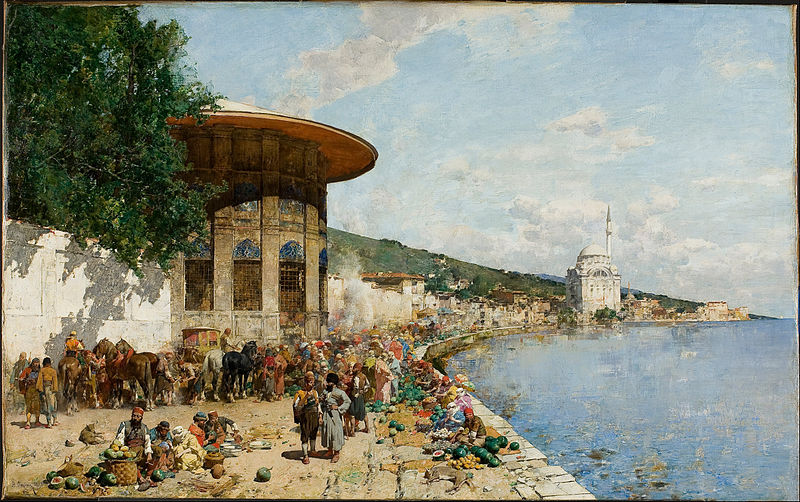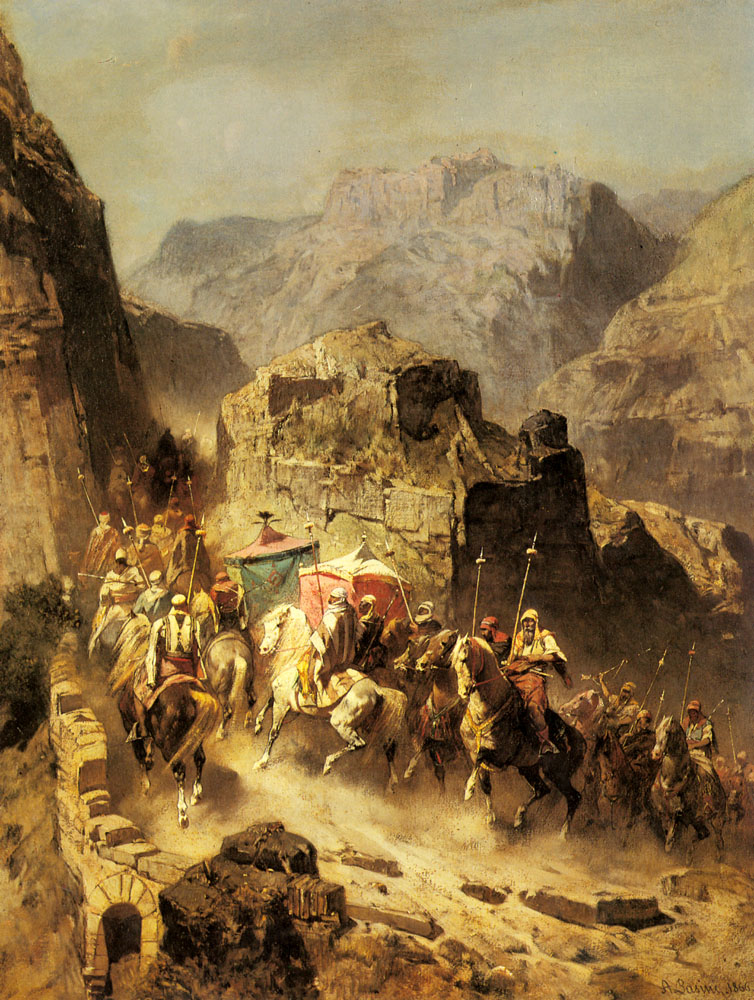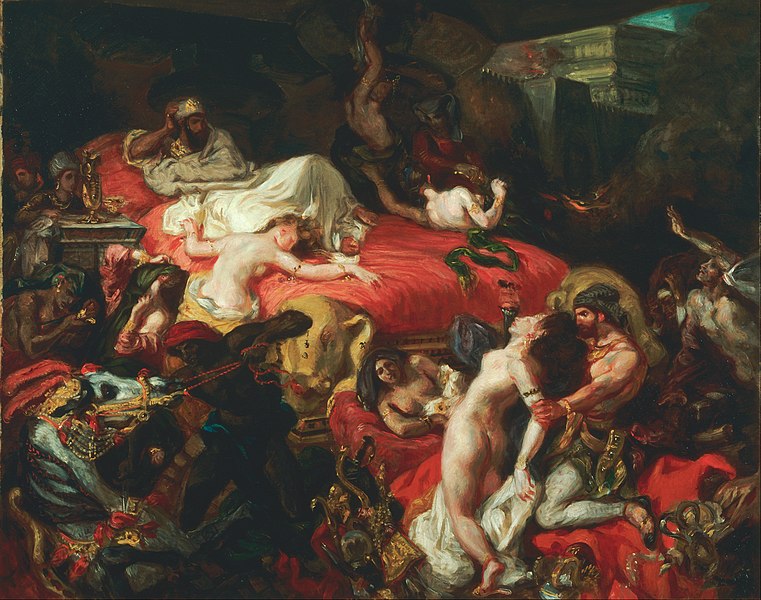ALBANIAN GUARDS IN BURSA, TURKEY
By John Frederick Lewis
Watercolour over pencil, heightened with bodycolour, black chalk
Premium Access - Upgrade Now >>
19.69 X 14.57 in (50 X 37 cm)
His very careful and loving representation of Islamic architecture, furnishings, screens, and costumes set new standards of realism, which influenced other artists, including the leading French Orientalist painter Jean-Léon Gérôme in his later works. Unlike many other Orientalist painters who took a salacious interest in the women of the Middle East, he "never painted a nude", and his wife modelled for several of his harem scenes. These, with the rare examples by the classicist painter Lord Leighton, imagine "the harem as a place of almost English domesticity, ... [where]... women's fully clothed respectability suggests a moral healthiness to go with their natural good looks" More
SEATED ARAB MERCHANT AT SUEZ
By John Frederick Lewis
Watercolour over black chalk, heightened with bodycolour and gum arabic
13.78 X 17.32 in (35 X 44 cm)
AN OLD SULIOTE
By John Frederick Lewis
Watercolour, black chalk and bodycolour on buff-coloured paper
14.96 X 10.83 in (38 X 27.5 cm)
INTERIOR OF SULTANAHMET CAMII (THE BLUE MOSQUE), CONSTANTINOPLE
By John Frederick Lewis
Watercolour over pencil
21.26 X 14.76 in (54 X 37.5 cm)
OUTDOOR GOSSIP, CAIRO, c. 1873
By John Frederick Lewis
Oil on board
12.01 X 7.87 in (30.5 X 20 cm)
THE DOUBTFUL COIN, c. 1869
After John Frederick Lewis
Watercolour and gouache
8.07 X 9.37 in (20.5 X 23.8 cm)
THE WADI AT BOU SAADA, c1893
By Eugène-Alexis Girardet
Oil on canvas
26.77 X 42.91 in (68 X 109 cm)
Eugène Alexis Girardet (31 May 1853, Paris - 5 May 1907, Paris) was a French Orientalist painter. He came from a Swiss Huguenot family. His father was the engraver Paul Girardet (1821-1893). He studied at the École des Beaux-arts and in the studios of Jean-Léon Gérôme, who encouraged him to visit North Africa in 1874.
In all, he made eight trips to Algeria after 1879, especially to the south, around the oases of Biskra, El Kantara and Bou Saâda, where he worked with Étienne Dinet. In 1898, he visited Egypt and Palestine, producing many works depicting the lives of desert nomads.
He exhibited regularly at the Salon and with the Société des Peintres Orientalistes Français (of which he was one of the founding members), with major shows at the Exposition Universelle (1900) and the Exposition Coloniale de Marseille of 1906.
In addition to several museums in France, his works may also be seen at the Dahesh Museum of Art and the National Museum of Fine Arts of Algiers. More
THE PASSING CARAVAN
By Eugène-Alexis Girardet
Oil on board
27 X 43.5 in (68.58 X 110.49
LE CORDONNIER, c. 1887
By Eugène-Alexis Girardet
Oil on board
13.19 X 15.16 in (33.5 X 38.5 cm)

Eugène Alexis Girardet
Le marchand de fruits, 1874
Oil on canvasSize:55 x 38 cm. (21.7 x 15 in.)
MARKETPLACE AT THE ENTRANCE TO A BAZAAR, CONSTANTINOPLE
By Alberto Pasini
Oil on linen
15.25 X 18.25 in (38.74 X 46.36 cm)
In 1853 his lithograph of The Evening gained him admittance to the Paris Salon, and to the workshop of the famous Théodore Chassériau. The eruption of the Crimean War offered a new opportunity, when in February 1855, this latter painter recommended Pasini to replace him on the entourage of the French plenipotentiary minister Nicolas Prosper Bourée to Persia. Pasini accompanied him, returning through the north of Persia and Armenia before reaching the port of Trebizond. In subsequent trips, he visited Egypt, the Red Sea, Arabia, Istanbul, and Persia. Pasini parlayed his exposures during this trip into numerous highly detailed paintings of orientalist subjects. He left again for Istanbul in October 1867, summoned by the French Ambassador Bourée. He returned to Turkey in 1876 to execute the four paintings commissioned by Sultan Abdul Aziz. He was about to return to Istanbul the next year, when his patron, the Sultan, died.
In 1865, he spent some time in Cannes, painted landscapes of the Riviera. During the Franco-Prussian War of 1870, he returned to Italy, settling in Cavoretto, on the hills around Turin. He continued to travel, closer to his home, with trips to Venice and two sojourns in Spain in 1879 and 1883. More

Alberto Pasini, (1826/1899)
Market Day in Constantinople, c. 1877
Berkshire Museum, Pittsfield, MA, United States

Alberto Pasini, (1826 - 1899)
Horse market, Syria
Oil on canvas
Height: 840 mm (33.07 in). Width: 1,030 mm (40.55 in).
Art Gallery of New South Wales

Alberto Pasini, (1826 - 1899)
Arab Caravan, c. before 1899
Oil on canvas
Alberto Pasini, 1826 - 1899
BY THE FOUNTAIN, CONSTANTINOPLE, c. 1882
Oil on canvas
46 by 38.5cm., 18 by 15¼in.
BY THE FOUNTAIN, CONSTANTINOPLE, c. 1882
Oil on canvas
46 by 38.5cm., 18 by 15¼in.
Delacroix Eugene
Arab Riders on Scouting Mission
Oil Painting on Canvas
36” inches wide by 18” inches high
Hermitage Museum
Ferdinand Victor Eugène Delacroix (French: 6 April 1798 – 13 August 1863) was a French Romantic artist regarded from the outset of his career as the leader of the French Romantic school.
As a painter and muralist, Delacroix's use of expressive brushstrokes and his study of the optical effects of colour profoundly shaped the work of the Impressionists, while his passion for the exotic inspired the artists of the Symbolist movement. A fine lithographer, Delacroix illustrated various works of William Shakespeare, the Scottish writer Walter Scott and the German writer Johann Wolfgang von Goethe.
In contrast to the Neoclassical perfectionism of his chief rival Ingres, Delacroix took for his inspiration the art of Rubens and painters of the Venetian Renaissance, with an attendant emphasis on colour and movement rather than clarity of outline and carefully modelled form. Dramatic and romantic content characterized the central themes of his maturity, and led him not to the classical models of Greek and Roman art, but to travel in North Africa, in search of the exotic. Friend and spiritual heir to Théodore Géricault, Delacroix was also inspired by Lord Byron, with whom he shared a strong identification with the "forces of the sublime", of nature in often violent action.
However, Delacroix was given to neither sentimentality nor bombast, and his Romanticism was that of an individualist. In the words of Baudelaire, "Delacroix was passionately in love with passion, but coldly determined to express passion as clearly as possible. More

Eugène Delacroix (1798–1863)
Death of Sardanapalus, c. 1844
Oil on canvas
73.71 × 82.47 cm (29 × 32.5 in)
Philadelphia Museum of Art
Death of Sardanapalus, c. 1844
Oil on canvas
73.71 × 82.47 cm (29 × 32.5 in)
Philadelphia Museum of Art
The painting's most dominant feature is a large divan, with its golden elephants, on which a nude prostrates herself and beseeches the apathetic Sardanapalus for mercy. Sardanapalus had ordered his possessions destroyed and concubines murdered before immolating himself, once he learned that he was faced with military defeat.
The Death of Sardanapalus is based on the tale of Sardanapalus, the last king of Assyria, from the historical library of Diodorus Siculus, the ancient Greek historian, and is a work of the era of Romanticism. This painting uses rich, vivid and warm colours, and broad brushstrokes. It was inspired by Lord Byron's play Sardanapalus (1821). More

Eugène Delacroix (1798–1863)
The Lion Hunt, c. 1885
Oil on canvas
Nationalmuseum, Stockholm, Sweden

Eugène Delacroix (1798–1863)
The Combat of the Giaour and Hassan, c. 1826
Oil on canvas
58 × 71 cm (22.8 × 28 in)
Art Institute of Chicago
The Combat of the Giaour and Hassan, was inspired by a poem by Lord Byron, The Giaour.
Byron wrote the poem during his Grand Tour during 1810 and 1811. While in Athens, he became aware of the Turkish custom of throwing a woman found guilty of adultery into the sea wrapped in a sack. "Giaour" (Turkish: Gâvur) is an offensive Turkish word for infidel or non-believer, and is similar to the Arabic word "kafir".
The main story is of Leila, a member of her master Hassan's harem, who loves the giaour and is killed by being drowned in the sea by Hassan. In revenge, the giaour kills him and then enters a monastery due to his remorse. The design of the story allows for contrast between Christian and Muslim perceptions of love, sex, death and the afterlife. More

Ferdinand Victor Eugène Delacroix (1798 - 1863)
The Bride of Abydos, c. 1843
28 x 36 cm (10,8 x 14,0 inches)
Oil on canvas
Paris, Musée du Louvre
The Bride of Abydos is from another poem by Lord Byron in 1813. One of his earlier works, it is considered to be one of his "Heroic Poems", along with The Giaour, Lara, The Siege of Corinth, The Corsair and Parisina. These poems contributed to his poetic fame at the time in England.
After an initial description of the Turkish setting, the story opens with the ruler Giaffir rebuking his supposed son, Selim. Selim professes his love for his half-sister, Zuleika, Giaffir's daughter. Angered, the Pasha refuses Selim a key to the royal harem and upbraids him with insults.
Zuleika herself appears, radiant in beauty, and soon she is forbidden to marry Selim; she tacitly complies. Later, she exclaims her love to Selim and mourns her fate that would be without him. He, in turn, decries Giaffir's judgment as well and vows vengeance.
The second canto again opens with a chthonic description of the Turkish lands and the grotto where the two lovers meet. Cloak thrown aside, Selim is dressed as a dashing pirate and declares that Zuleika is not his sister. She is surprised and listens as Selim relates how Giaffir had killed Abdallah, Selim's father and Giaffir's brother. Selim's story continues as he tells her that he learned of his true identity from one of his father's loyal servants, Haroun, and that since Selim himself as raised by Giaffir, he was detested and maltreated.
He became a pirate so that he could gather a posse for revenge, and asserts his lust for Giaffir's blood; the silence at the end of Selim's tale is interrupted by the reports of weapons belonging to Giaffir's men. Selim, wishing to kiss his love one last time, tarries to leave the cave and soon falls, dying on beach, the fatal blow administered by Giaffir himself. The second canto thus ends with Zuleika dying in sorrow for Selim and Giaffir is forced to live out the rest of his life in solitude. More
Eugène Delacroix (French, 1798 - 1863)
Episode from "The Corsair" by Lord Byron, French, about 1831,
Watercolor, brown ink, touches of gouache, over graphite underdrawing
24.3 x 19.2 cm (9 9/16 x 7 9/16 in.)
J. Paul Getty Museum
The Corsair was also inspired by another tale in verse by Lord Byron published in 1814, which was extremely popular and influential in its day, selling ten thousand copies on its first day of sale. The Corsair, published in 1814, tells the story of Conrad, a wild and ruthless Aegean pirate whose only virtue is the love he feels for the gentle Medora. There is nothing remarkable about his appearance, Byron tells us, but beneath the quiet exterior there is passion, pride and a defiant, calculated callousness, characteristics that set him apart from other men. Brutalised by childhood ill-treatment, detested and feared, Conrad is a lonely tragic hero who is destined never to enjoy peace or happiness. The Corsair was an immediate success, confirming Byron’s importance as the most popular and influential poet of his generation. More
Images are copyright of their respective owners, assignees or others

No comments:
Post a Comment